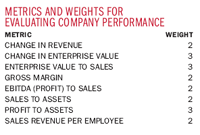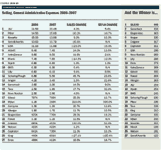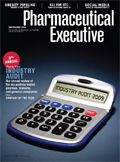- Sustainability
- DE&I
- Pandemic
- Finance
- Legal
- Technology
- Regulatory
- Global
- Pricing
- Strategy
- R&D/Clinical Trials
- Opinion
- Executive Roundtable
- Sales & Marketing
- Executive Profiles
- Leadership
- Market Access
- Patient Engagement
- Supply Chain
- Industry Trends
Industry Audit 2009
Bill Trombetta expands his annual guide to stellar performance with the "Heavenly 27."
What’s the best managed pharma company?Listen to the Industry Audit and Company of the Year Podcast
Cast against a backdrop of global recession and pressure on the business model that is blurring the traditional strategic divide between generic and originator products, St. Joseph's University Professor Bill Trombetta presents our Eighth Annual Pharma Industry Audit, which this year digs deeper into current business trends by adding 11 new companies to the survey.

The highlights: "Stealth Pharma" takes the Company of the Year honors, with newcomer Gilead Sciences posting a convincing win based on an impressive profit-to-sales ratio reinforced by strong management of its asset portfolio. In second place is Genentech, with an exclusive product franchise in oncology that continues to deliver premium prices. Meanwhile, the 2007 Company of the Year, Biogen-Idec, falls to third on the heels of a steep drop in one key metric: shareholder value.
The lesson from this year's Audit is that it's how you grow that counts. And the organic growth that drives long term profitability is in scarce supply among the industry's standard bearers, with four of the top 10 companies in terms of sales—Pfizer, Sanofi-Aventis, GSK, and Merck—offering negative growth to shareholders. Still, with its enormous cash hoard, Big Pharma has the capacity to buy what it cannot build, and the current capital crunch in biotech has opened the door to acquisition of products, pipelines, and expertise at bargain prices—suggesting that the major players in the industry are slowly repositioning for better days ahead.
—William Looney, Editor-in-Chief
Pharmaceutical Executive's Eighth Annual Industry Audit analyzes the 2007–2008 performance of 27 publicly traded companies that file 10-K or 20-F reports on an annual basis with the US Securities and Exchange Commission. As in past years, the audit includes a wider array of performance metrics than found in the standard financial and accounting statements. Drawing on this larger set of sources allows for a more meaningful picture of performance, analyzing such key metrics as enterprise value in proportion to sales—a mission-critical driver of future prospects that focuses on profitability growth through product and process innovation. In addition to the 10-K and 20-F reports, the audit relies on proprietary and non-proprietary databases, as well as a broad array of secondary sources ranging from the business press to investor reports.
The key difference in this year's audit is an expansion in the number of companies examined, including those listed in Pharm Exec's separate survey of the 10 "stealth pharma" firms, last profiled in our June issue ("Stealth Pharma," June 2009). These include most of the emerging players in the biotech, orphan drugs and generics sectors, which were chosen for their high profile in the investment and scientific communities. Many are future leaders in the industry, with the scale, flexibility, and sophistication to fill the gaps exposed by the bureaucratization of Big Pharma brought on by two decades of consolidation.
The Pharma Industry Audit is also uniquely positioned to demonstrate whether a company's business strategy is actually enhancing shareholder value. If there's one metric that is the equivalent to food and water on a desert island, it's Enterprise Value. The market tempest of the past 18 months does carry a silver lining in that it forces investors to refocus on fundamentals. In the case of management, the measurement for success is simple: Do you create shareholder value or destroy it? For this reason, the audit gives highest priority to "Change in Enterprise Value" and "Enterprise Value to Sales." These numbers reflect a firm's market capitalization plus liabilities minus cash, or about what it would take to buy the firm on the open market. "Return on Assets" is another worthy exemplar of a commitment to long term profitability, and thus is given a significant weighting in the audit.
To accommodate the expanded sector profile, we've done some streamlining in the number of performance metrics, eliminating the earnings per share, price to earnings multiple, and R&D spend to sales indices. This allows a more focused examination of the indicators that matter most to investors.
With only eight metrics, the weighting formula of the audit has also been changed, with three of the metrics (covering value recognition and asset performance) weighted at 3 and the remaining five metrics weighted at 2. (The prior division of weights was set at 3, 5, and 7.) The audit retains the non-metric macro indicators on a scale and size that allow for viewing company performance in the context of overall industry trends.
Thus, determination of the final standing for each company relies entirely on the metrics—but not all metrics are equal. For instance, if a company places 10th out of 27 on a metric weighted at three, it receives (10 x 3) 30 points. Each company's points across all of the metrics are then totaled for a final score, with the company receiving the highest number of points overall designated as the Company of the Year.
Macro Benchmarks: Recession Spins Record Low Sales Growth
No performance audit is complete without an overall picture of the macroeconomic environment that all pharma competitors must confront. Medicines have been a key casualty of the worsening global economy, particularly as public budgets face the strain of higher unemployment and the increasing costs of benefits in aging societies.
In contrast to previous downturns, the pharma industry has proved not to be a "safe haven" against recession. The IMS forecast for 2009 indicates the global recession will push growth in pharmaceutical sales to less than 3 percent (topping $750 billion), down from nearly 5 percent in 2008.
A significant pullback has been underway for several years in the US market, with sales growth for this year pegged at around one percent, or approximately $300 billion, down from 3.8 percent. The steep shortfall in demand has been accompanied by stiffer resistance to price increases among US payers, with prescription unit growth forecast to rise by only 0.9 percent over 2008.
Three key conclusions can be drawn from analysis of the macroeconomic environment. First, the industry is no longer immune to broader structural pressures confronting the global economy and can be expected to be a target for cost-cutting as the size of the health sector increases in proportion to the overall economy. Second, the US is no longer the growth driver for the industry worldwide, a trend that could be accentuated if comprehensive health reform legislation is enacted later this year. Third, the capacity of the industry to exert pricing power against a consolidating payer base is shrinking fast, suggesting that future growth is going to depend on a much more robust value proposition for products competing in crowded therapeutic fields.
With this as the essential context, let's review the details driving results for the 27 surveyed companies.
SALES & SALES GROWTH
Figure 1 ranks our "Heaven 27" from highest dollar sales to lowest dollar sales in 2008. The gap is significant, from Johnson & Johnson, the poster child for decentralized diversification, at $63.8 billion; to Endo, a specialty drugmaker focused on pain management, at $1.3 billion. This metric illustrates how the industry's current "Big Five" are in fact a statistical anomaly, considering the more modest size of most of the companies in the audit. Of the "Stealth 10" now added to the survey, only one—Teva, at $11.8 billion—has revenues of more than $10 billion.

FIGURES 1 & 2
Much more important than total sales is the capacity to grow revenues, particularly in the current ravaged economy, with its fiscal deficits and steep budget cuts for reimbursed medicines. Figure 2 illustrates the maxim "grow or die." In a hostile demand environment, achieving real growth based on customer acceptance of value is no easy feat. Mylan Labs, a leader in generic and specialty drugs, snared the number one spot in revenue growth for 2008—and by a large margin, outpointing runner-up Celgene nearly two to one.
Mylan's success highlights the importance of how you grow. The company has a global strategy for generics, and is building a strong presence in 13 of the largest emerging markets to leverage its number two position in US scrips.
By contrast, the industry's historic, high profile symbols of global innovation—Pfizer, Merck, GSK, and Sanofi-Aventis—each scored negative growth in 2008. Schering-Plough was the notable exception among Big Pharmas, ranking number three with a 45.7 percent surge in revenue due to a strong international market presence and new product introductions. This ranking indicates how important the planned combination with Schering-Plough is to Merck in expanding its therapeutic portfolio and geographic footprint outside the US.

Metrics and Weights for Evaluating Company Performance
Nevertheless, Big Pharma's reliance on mergers and acquisitions provides little evidence that it will serve as a sustainable alternative to organic growth. The attraction is capturing a viable product portfolio and lower expenses, but the flip side is the deadly bureaucratic confusion that diverts attention and effort from what really counts. This is the focus on the customer rather than your fellow combatants in the struggle to create a new internal hierarchy. You can count the mergers that are truly a strategic fit, and hence worth risking the disruption in an intensely human business, on just one hand—and you won't need all your fingers. Pfizer's big move in bidding for Wyeth is not (in the opinion of many analysts) one of them.
Enterprise value and change in enterprise value As noted, this is the Holy Grail of metrics: Companies either create shareholder value or destroy it. Similar to absolute level of sales, the absolute value of an enterprise is a function of the sales level. We would expect a firm like Johnson & Johnson, at $64 billion in sales, to have a much higher enterprise value than a firm like Cephalon, with only $2 billion. Figure 3 shows the enterprise value ranking of our firms.

FIGURES 3 & 4
Change in Enterprise Value from 2007 to 2008 provides a snapshot of which of our 27 companies have their best days ahead. (See Figure 4 For this reason, Change in Enterprise Value is weighted at 3, as over time the Industry Audit has shown that it is a nearly foolproof indicator that shareholders are getting what they expect from the stock.
King and Mylan sport the highest shareholder value creation, at 140 percent and 137 percent, respectively, with Genentech and Teva next in line. Again, Schering-Plough is the only Big Pharma that did not destroy value for shareholders from 2007 to 2008. Among the biotechs, Cephalon and Amgen did relatively well for shareholders as well. The rest of the 27 companies contributed to the erosion of shareholder wealth found throughout the equity markets in 2008. Forest Labs came in last in this metric, with a 52.3 percent reduction in shareholder value for the year due to an increasingly fragile position for its in-patent portfolio.
The second metric weighted at level 3 is Enterprise Value to Sales. This metric normalizes the differences in scale due to absolute dollar revenue. Figure 5 places each of the 27 surveyed companies, and indicates which direction the ratio went from 2007 to 2008. Success in this metric is harder to achieve in a climate marked by intensive pricing pressures, economic disarray, and significant regulatory concerns about safety and risk. Only Amgen, Genentech, Teva, and King were able to wrest an EV to Sales increase in 2007–2008.

FIGURES 5 & 6
The placing of firms relative to EV to Sales is shown in Figure 6 and makes for our second 3-weight metric. Celgene is the clear winner in this metric due to the fact that its shares have been heavily discounted despite its strong therapeutic franchise in multiple myeloma, where it enjoys an unusual amount of pricing freedom due to a state-of-the-art treatment.
This metric is also an indicator of market perceptions that firms are on the upswing—or, alternatively, that their best days are behind them. The higher the ratio, the greater the likelihood that a firm's growth will outpace its peers in both sales and profit.
Gross margin Figure 7 shows gross margin for each firm, along with an indication of increase or decrease in 2007–2008. Gross margin reflects a firm's pricing power, in terms of the ability to get price increases or at least maintain prices. The lesson behind these numbers is: the higher the gross margin, the better.
Eight of the 27 audited companies show a decrease in gross margin from 2007, a trend reflective of the capacity of payers to dictate terms on pricing. Biogen-Idec displayed the most aggressive pricing prowess in the critical US market, allowing it to reach a gross margin of over 90 percent—highest of the group. This is largely due to its therapeutic dominance in areas of high medical need, like MS.

FIGURES 7 & 8
Figure 8 ranks companies on the basis of gross margins for 2008. As noted, this ranges from Biogen-Idec's 90.2 percent down to the "stealth generic" off-patent companies with limited protection on prices. Endo, with an impressive markup ratio of 78.8 per cent, is the notable exception here—a consequence of the company's position in generics that are difficult to manufacture. Allowance of a regulatory pathway for biosimilars in the US may even out this trend somewhat.
Profit margin or margin management High profit margins are a function of good management, with particular attention paid to cost control. This in turn drives the larger financial performance measure of EBITDA: earnings before interest, taxes, depreciation, and amortization. In essence, EBITDA determines the level of profit against sales. The higher this ratio, the more impressive a firm looks to shareholders and the investment community. Figure 9 shows Gilead Sciences at a very impressive P/S ratio of 52.6 percent.

FIGURES 9 & 10
More important, the ranking indicates that generics companies can build an alternative future from that of commodity producers condemned to a life of pumping volume sales to accommodate razor-thin margins. Producers are staking out a role in higher end specialty medicines and aggressively engaging around biosimilars, which if approved by regulators can command higher price points. Three key generics companies—Endo, King, and Teva—are doing better than half of the 27 in terms of profitability. Endo itself posts a profitability performance superior to Big Pharma players like Wyeth, Merck, Lilly, Johnson & Johnson, Abbott, and BMS.
Sales per assets Figure 10 sets the benchmark for company productivity in managing assets. It shows how a firm's productivity changed from 2007 to 2008 in terms of sales revenue divided by the assets held on its books. The higher the ratio, the more productive a firm is over the course of the year. Roughly half of the 27 companies in this year's audit posted modest improvements in 2008 over 2007. This metric is unique in that the company can produce results from actions it can initiate and execute under its own control. This should be a key management priority now that it's harder to wrest profits by unilaterally raising prices.
Ranking of overall productivity is highlighted in Figure 11 with Novo Nordisk in the top spot. Its .900 ratio means that for every dollar Novo Nordisk invests in assets, it generates 90 cents in revenue. Hence, there is another way to generate profit: by not only focusing on margins, but also on how well assets are managed.

FIGURES 11 & 12
Profit to assets or return on assets When we combine Profit to Sales with Sales to Assets, we get a very important metric: Return on Assets. The higher this ratio is, the more impressive a firm's performance. Figure 12 shows Gilead and GSK at the top of the ranking, reflecting stellar management of assets to maximize profit margins. But it's profits, of course, that drive the returns to shareholders, which is why Gilead Sciences, paced by its emergence as the industry leader in advanced HIV therapies, has been an attractive purchase for institutional investors for some time.
Sales revenue per employee How productive is the company's work force? Figure 13 highlights this increasingly important metric. GSK, Abbott, Genentech, Teva, Novo Nordisk, and Cephalon were the laggards, posting lower sales per employee in 2008 against 2007.

FIGURES 13 & 14
Figure 14 shows firm employee productivity against sales for 2008. Gilead once again is on top with an impressive $1.53 million in sales per employee—roughly three times the ratio for industry giants like Pfizer and Johnson & Johnson. A key question for Pfizer is whether more cost-cutting from job reductions will yield increased productivity per worker employed. The record from past mergers suggests that payoff will take years to accomplish.
Selling, general, and administrative expenses This is a metric much in vogue in the current era of declining demand. With industry revenues more or less flat, management needs to scrutinize its overhead in terms of selling, general, and administrative expenses. Figure 15 compares the extent that a firm either increases or decreases its SG&A compared to whether its sales revenue increased or decreased. In general, it is better for a firm to increase its sales more than its overhead even if the latter is necessary to help establish a new medicine for success in the market. SG&A increases higher than sales increases are not good for a company, particularly over the long term.

FIGURES 15 & 16
For example, Gilead increased sales over the year 25.3 percent, but increased SG&A at half that rate. Meanwhile, Amgen's sales increased by only a meager 1.5 percent— and SG&A rose by more than 22 per cent.
And the winner is...
Gilead Sciences followed by Genentech and Biogen-Idec.
Stripped of weights and looking at things from a more intuitive perspective—who came in first, second, third, etc., and who came in last, 26th and 25th from top to bottom—consider the strength of Gilead's performance: it scored in single digits on 7 of the 8 metrics, by definition in the top third of performance. The only metric Gilead comes up short on is its asset management. On the other hand, note how consistent some firms are at displaying mediocre performance, by being disproportionately ranked in the bottom third placements, from 20 to 27.

DR. BILL HALL OF FAME
Strategy: The Forgotten Buzzword
Besides its strong management metrics, Gilead Sciences earns the top nod with a novel strategic focus on what is arguably today's most challenging therapeutic category: HIV/AIDS. In a short two decades as a publicly traded company, Gilead has prevailed over the competition by anticipating changes in the profile of HIV/AIDS, as a priority disease and as a driver of social policy—both of which affect the climate for reimbursement. Where others have encountered only reputational risks, Gilead has earned the confidence of the specialist clinicians that determine success in the HIV space.
In turn, management has leveraged its weight in HIV to branch out in other therapeutic areas, including hepatitis B, and cardiovascular and respiratory conditions. The strategy is not without costs, as building global market share is a challenge for all the smaller "stealth pharma" companies and Gilead is no exception, as evidenced by recent pressure on the share price.
WHAT'S THE STORY ON BIOGEN-IDEC? Our number one performer for 2007 dropped to third in 2008. The company's key strength has been the ability to raise prices, with its benchmark Avonex therapy for MS rising 22 percent, according to The Wall Street Journal. Its dominant position in a few key therapeutic areas accounts for its 90 percent margins, the only company in this year's Audit to occupy that rarified space. But despite its pricing prowess, shareholder value at Biogen-Idec still slumped more than 20 percent, as did Enterprise Value to Sales, to a modest 3.47, knocking the company out of contention for a second run at the top slot. The reversal in these key metrics are reflective of the upfront costs, risks, and management challenges in diversifying the portfolio for long term success.
THE URGE TO GET SMALL The audit results suggest that BMS and Lilly are aiming to become pure biotechs, with an emphasis on oncology. Yet their size and the complexity of administering a diverse portfolio of medicines could hamper their efforts to match the nimble, entrepreneurial footing and focused orientation of a biotech. Enterprise Value to Sales decreased for both companies in 2008, to levels that don't reflect any future prospects as hosts for a range of fledgling biotechs, and at less than 70 percent, BMS' gross margin falls short of the margins posted by the best biotechs. While both Lilly and BMS saw improvement in Sales per Employee productivity, their respective levels do not approach biotech levels. The rankings indicate that significant operational and philosophical changes are needed if either company is to achieve the transformation from a small-molecule major to long term success as a biotech powerhouse.
PFIZER'S UNTAPPED MEDICINE CABINET The world's top-selling pharmaceutical company has had a rough decade, especially in terms of shareholder value. But Pfizer is taking steps to reposition, including a pending merger to consolidate its hold on the top sales rank and a plan to offset the 2011 patent expiration of flagship drug Lipitor with a new focus on emerging markets. But the company's most intriguing move is its move toward generics. Wendy Diller, in a March 2009 In Vivo article, lays out a smorgasbord of older patent-expired drugs Pfizer owns that together make up as much in sales as Lipitor, including one drug, Medrol, which has been on the market for 50 years, with peak sales of $400 million in 2008.
BRIDGING THE "SUPERMARKET SPREAD" Reinforcing Big Pharma's interest in generics and fast-growing emerging markets is the message behind Procter & Gamble's pullout from the drugs sector. In a blog in FinancialTimes.com posted in February, then-CEO A.G. Lafley remarked: "Today, shares in pharma companies trade at multiples at or below most of our consumer staple products." Put another way, shareholder value is likely to be enhanced more by investing in Tide, Swiffer, Crest, and Pampers, than in prescription pharmaceuticals.
Bill Trombetta is professor of pharmaceutical marketing and strategy at the Erivan K. Haub School of Business at St. Joseph's University in Philadelphia. He can be reached at dtrombet@aol.com

